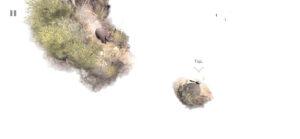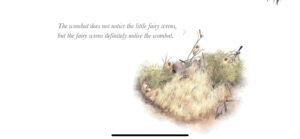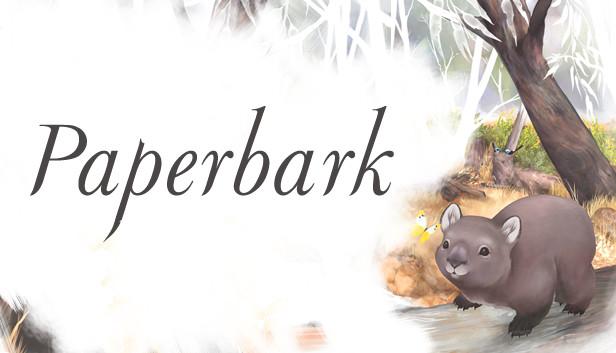Paperbark is a charming, short story which follows the journey of a small wombat in Australia, who is in search of a new home after a bushfire tragically took his previous home. Paperbark was released in 2018 by Paper House, and is available on mobile devices as well as on the PC. In this game, players travel through the Australian wildlife as the wombat, foraging items along the way and interacting with other wildlife. This game is available in the iOS app store, and I played the game on my mobile device. This simple and beautiful game acts as a form of escapism for players, and although being single player, is family friendly and open to players of all ages. Within this game, walking serves as a form of interactive discovery, allowing players to become fully immersed within the vibrant game settings while following the story of a wombat newly discovering his surroundings.
In Paperbark, interactive walking is used as a form of exploration, using the aesthetics of discovery and sensation to allow players to become fully immersed in the narrative. In Paperbark, players are guided through the wild forage of Australia as a curious wombat. In the game specifically, players are guided to “paint” in the setting as they explore it, slowly unveiling parts of the setting that was filled with blank space before.

Figure 1: Players are guided to use their finger to “paint” in the setting.

Figure 2: This “painting” mechanism is used to “fill in the blank” of the unknown setting.
Through this mechanism of painting, which must be done before the wombat can walk through the spaces, defines the way that players must discover their surroundings, just as the wombat is discovering its new surroundings. This is quite different from typical walking simulators, such as What Remains of Edith Finch or Dear Esther, where the entirety of the setting is already shown to the players. In Paperbark, players must directly walk up to different parts of the scene to “paint” it in, making walking a direct medium for discovery. Rather than revealing the setting like traditional walking simulators, Paperbark utilizes negative space and the unknown to incentivize players to walk and discover. Hence, this reinforces the narrative that the wombat is being introduced into a completely new environment where nothing is known except for what’s in its direct vicinity, and players must walk to slowly paint in the full picture of the wombat in its surrounding. In addition, as the walking takes place, the beautiful shrubbery of Australia is slowly filled in; on top of the beautiful imagery, players can also listen to the wildlife and vibrant noises of the Australia setting. Occasional humming can also be heard; this allows the player to become fully immersed into the setting that the wombat is slowly discovering.

Figure 3: The wombat discovers more and more of its surroundings!
One critique I have about this aspect of the game is that it often makes it difficult to know when and where you have been previously, especially since much of the setting looks the same. It would be useful to add something like a map so that users are aware of where they are in the context of the rest of the setting. In addition, although there were subtle indicators of where the wombat could walk on with small pawprints, I think that making these prints more obvious could help users effectively navigate the environment rather than having them click a location multiple times before having to discover that the place is somewhere that the wombat can’t walk in. Despite these small pain points, this walking mechanism does a great job of letting players become immersed in the game and the scenery that comes with it. Consequently, the painting mechanism allows walking to act directly as a form of discovery into a world of sensations, allowing users to become fully immersed into the narrative of a wombat who is exploring its new home in Australia.
Furthermore, Paperbark utilizes walking as a way for players to extend its storytelling, utilizing game mechanics such as having a loose objective of collecting resources and proceeding through the wilderness by walking to proceed to later parts of the storyline. The game itself is split up into different “chapters”, where in each different chapter, a new setting is introduced to players, as seen below.

Figure 4: Example of a game chapter in Paperbark.
Hence, as users walk through each different setting, the wombat is able to proceed to different areas of its setting, allowing it to make more and more discoveries about new home that it is in. As seen above, after players progress through each level by fully walking through the wombat’s surroundings and discovering each part of the environment. Hence, walking fully through the wombat’s setting becomes the player’s objective, as they are able to unlock and discover new habitats for the wombat to explore as a result. In addition, as seen below, narration is provided after finishing each level, where bits and pieces of the storyline of the wombat interacting with the environment are introduced.

Figure 5: A example of narration in between chapters.
Hence, walking is used as a way for users to unlock different parts of the wombat’s stories and experiences as it progresses through its journey. In addition, players are given the objective of collecting different resources as the wombat discovers its environment.

Figure 6: Players walk and collect items that the wombat can eat or forage for.
As seen above, players walk in order to find these resources, which includes items beneficial for the wombat, such as various bugs, flowers, and plants.

Figure 7: Wombat eating flowers.
As seen above, players can directly discover these resources by walking around in the setting and pressing on these different resources. Because players have to thoroughly explore the environment to find these different resources and complete their objective, walking becomes a necessity to accomplish these tasks. Adding this objective of finding and collecting items are common in walking simulators such as Paradise Killer and Cloudpunk, where players must travel through the environment and collect different items. This is a common game mechanic to encourage players to walk around in the environment and discover, and in the context of Paperbark, this serves the narrative of helping the wombat survive in its new home. One critique I have in this objective for Paperbark was that it was unclear whether collecting the items would result in some kind of benefit. The collection of these resources were just presented as a task without any clear motive for doing so- it would have been nice to inform players if there’s any benefit to completing a collection (since my play time was limited to an hour, I was not able to “complete” any of the object categories”). Overall, Paperbark introduces different player objectives that encourage players to walk, all contributing to the narrative of a small wombat discovering its new surroundings and trying to survive in the process.
Overall, Paperbark successfully incorporates walking as a way for players to interactively discover their environments, allowing them to become fully immersed in the environment and the narrative of the wombat navigating its new home. Its use of “painting” to build an immersive environment and introducing game objectives to fuel this discovery ultimately makes this game a successful walking simulator.



